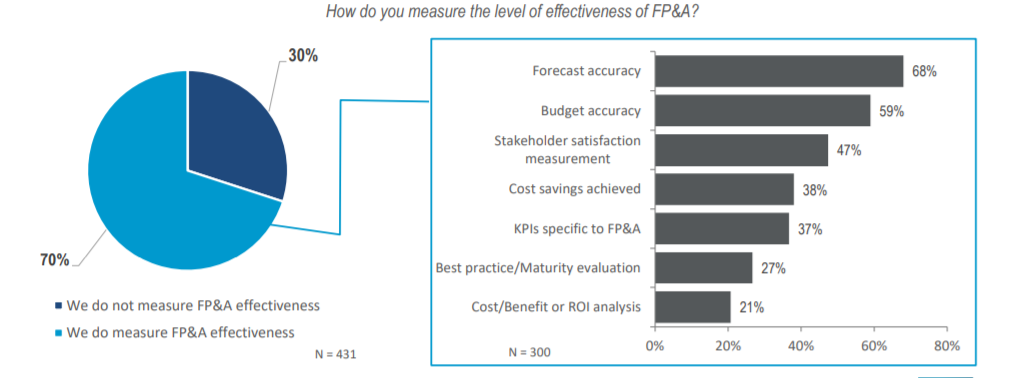Articles
Effectively Measuring Your FP&A Efforts
- By Rachele Collins
- Published: 9/16/2019
APQC and AFP recently engaged in a collaborative research project to understand leading practices for FP&A. Two-thirds of survey participants reported that their FP&A team’s contribution is at best moderately effective in contributing to the organization’s strategic goals. But how should FP&A organizations measure their effectiveness, and what does an effective measurement system look like for an FP&A team or department?
MEASURES OF FP&A EFFECTIVENESS
In the study we asked participants how they measure FP&A effectiveness, and found that nearly one-third of survey participants do not measure FP&A effectiveness at all. The frequency percentages for the remaining survey participants (who do measure FP&A effectiveness) is shown below, with the top measures being forecast (68 percent) and budget accuracy (59 percent).

Figure 1
EFFECTIVE MEASUREMENT OF FP&A
A conversation about measures for FP&A is important because, from a macro standpoint, measures are proxies for what the leadership team is saying that the organization values. From a micro standpoint, measures then drive the daily behavior of individuals. Therefore, an organization should carefully design its measurement system. APQC has been engaged in benchmarking and process improvement for more than 40 years, and recommends FP&A teams consider the following tenets when determining how to best measure their FP&A teams:
- Alignment: In order to ensure a strategic approach to measurement, APQC recommends that organizations trace the “value path,” or line of sight, between what the organization is measuring, and its ultimate objectives. For example, leaders of FP&A teams should engage in discussions as to what the desired outcomes of the group are, whether that be better inputs and analytics for decision-making, increased revenues, serving as a better business partner to key internal stakeholders, etc. And then FP&A team leaders should ideally be able to trace the measures of the department, and of the individuals who work in the department, back to desired outcomes in order to ensure an aligned system of performance. As illustrated in Figure 1, for example, something to consider is that, while more than half of organizations measure forecast and budget accuracy, few organizations are evaluating FP&A effectiveness based on business results-type measures like cost savings or ROI proxies.
- Balanced and Key: APQC advises organizations to measure and monitor a balanced set of measures (for example, financial, customer, internal/process, learning and growth), and not to overly focus on any one category to the detriment of others. For example, in Figure 1, stakeholder satisfaction could be argued to be just as important as other measures of FP&A, and yet less than half of survey participants say they are measuring this. And don’t forget the importance of measuring employee satisfaction, as well as measures of learning and growth (like training and development), as other important measures for the FP&A team. Also, measures of performance should ideally focus on the critical few; too many and it easily gets overwhelming and dilutes focus and performance. And finally, FP&A organizations should think about a balance of numeric and more qualitative measures. For example, in addition to some of the more quantitative measures listed in Figure 1, FP&A teams might consider documenting and communicating success stories, such as examples of stellar business partnership or decision-making support, from the group.
- Input and Control: It is also important to solicit the input by leaders of FP&A team members in terms of what the group should be measuring. People buy into what they help create, and ideally the measures (particularly if they relate back to any kind of performance conversations) should be within the scope of the FP&A team’s control. For example, as shown in Figure 1, forecast accuracy is often used to describe and measure FP&A teams. But forecasts are in essence predictions of future results, and subject to many forces affecting the forecast, some of which are within the organization’s control, and some that are not.
- Periodic Review: And finally, the FP&A team should review the measurement system periodically to ensure that it is driving the right behaviors. For example, back to the most frequent measure in Figure 1 of forecast accuracy: In some cases, this might encourage organizations to be overly conservative versus realistic in their forecasts. Is that driving the right behaviors in the FP&A team? If not, then a discussion and realignment may need to occur.
Interested in participating in an engaging discussion about how to measure your FP&A effectiveness? Join us at AFP 2019 in Boston on October 21 for an interactive panel entitled “Measuring the Success of your FP&A Team.” We’ll discuss what effectiveness means for FP&A, why FP&A as a profession hasn’t been more effective, and how organizations are measuring their effectiveness. We hope to see you there.
Rachele Collins is Principal Research Lead, Financial Management for APQC.Copyright © 2024 Association for Financial Professionals, Inc.
All rights reserved.

